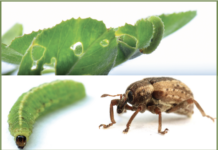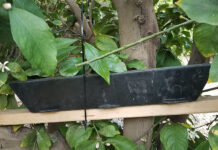
California red scale (CRS) is an armored scale insect that affects all citrus varieties. It attacks all aerial parts of the tree including leaves, fruits, twigs and branches by sucking on plant tissue with its long filamentous stylet. Heavy infestations cause leaf yellowing and drop, dieback of twigs and occasional death of the infested tree. Heavily infested fruits with patches of California red scale may be downgraded in the packinghouse. For managing CRS, an integrated approach that combines mating disruption, insecticides and biological control using Aphytis melinus is used. Growers and PCAs have long relied on using pheromone cards for monitoring males and use of degree days to predict future events for making treatment decisions. Insecticide applications give the best results when the population is at the most susceptible stage (immatures) and is uniform.
In a normal year, monitoring for CRS begins on March 1. PCAs put out pheromone cards and call a biofix when first males are caught on the trap (biofix is the first event in CRS seasonal cycle.) In 2023, we got many calls from PCAs that their traps were empty in March. Our observation at the Lindcove REC center was the same. First males were found on trap cards on the week of April 10 and common consensus for biofix day was April 11. This situation is true for major citrus growing counties in the San Joaquin Valley.
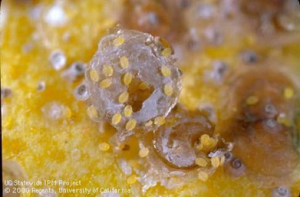
How Do Lower Temps Affect CRS and its Management?
Like all other insects, development of CRS is temperature dependent. Season starts with surviving overwintering females. As the temperature increases and heat units accumulate, gravid female produces crawlers (Figure 1). Crawlers only remain mobile until they find a suitable location to begin feeding. Once they start feeding, they do not move and go through development being attached to the feeding spot. Crawlers go through active feeding stage (instars) and a dormant period (molting). Females molt twice and males molt four times and emerge as fliers. Males are the only other moving stage (Figure 2). Males find and mate with third instar females. Afterwards, gravid female starts producing crawlers, hence completing the life cycle. In the San Joaquin Valley, there are four complete generations of CRS. In years with warm winters/hot summers, partial fifth generation (immatures/males) have also been reported.
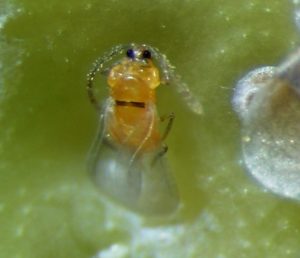
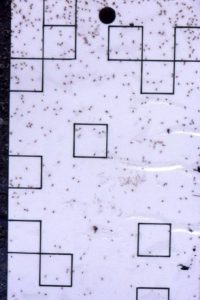
CRS does not develop below 53 degrees F, and it is the lower developmental threshold (LDT) temperature based on which degree days for CRS development are calculated. Using CIMIS station data for four counties (Kern, Tulare, Fresno and Madera), I calculated the cumulative degree days above the LDT for CRS since 2020. Figure 2 shows degree days in 2023 trails below those for years 2020-22. Effects of low average daily temperature were first noticed when biofix was delayed by about four weeks in all four counties. Figure 2 (see page 8) shows number of males/trap at Lindcove REC station, where biofix and first-generation flight peak were about four weeks later than in 2022. Second-generation flight started on the week of June 19, which is also about four weeks delayed. This means CRS is developing, but at a slower rate than it had been in earlier years (Figures 2 and 3). It takes 550-degree days after the male flight for crawler emergence. Expect second-generation crawler emergence, third-generation male flights and consequent generations to be delayed. Relatively cooler spring and early summer temperatures mean less heat units/day and delayed development, thereby affecting male flight and crawler emergence, which will in-turn affect spray timing for CRS control in the 2023 season. Visit lrec.ucanr.edu/Citrus_IPM/Degree_Days/ for degree day updates in Kern, Tulare, Fresno and Madera counties.
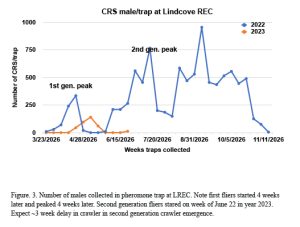
Management
Monitoring
Monitoring for California red scale and applying treatments to target the most susceptible life stage/generation is key to managing CRS. Goal is to maintain CRS populations at low levels to minimize fruit contamination at harvest. UC IPM guidelines has a list of updated recommendations.
Mating disruption
Mating disruption such as Checkmate CRS prevents or delays mating of males with females. Unmated females do not produce crawlers and stay as third instar females which is the preferred stage of parasitism by Aphytis melinus. Application of mating disruption (180/acre) prior to the onset of first or second generation (March or May) have shown to provide best results (Grafton-Cardwell et al. 2021).
Biological control
Parasitic wasps Apytis melinus and Comperiella bifasciata are important natural enemies that help manage CRS. However, these parasitoids can be susceptible to insecticides used for other pests, so their effectiveness depends on careful monitoring and use of selective insecticides (UCIPM Guidelines 2022).
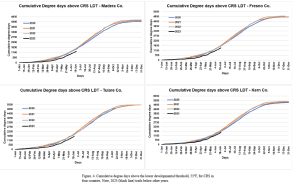
Insecticides
Several insecticides have proven efficacy against CRS (UCIPM Guidelines 2022, Grafton Cardwell 2016). However, a number of populations have developed resistance to organophosphates and carbamates. Field observations show resistance to pyriproxyfen may have developed (UCIPM Guidelines 2022). Where resistance to carbamates or pyriproxyfen is suspected, use of alternate chemicals such as buprofezin, spirotetramat, mating disruption and release of Aphytis may provide better results (UCIPM Guidelines 2022).
California Red Scale Trial, 2022
A field trial to evaluate multiple insecticide treatments on California red scale was conducted at the Lindcove Research and Extension Center in 2022 (Gautam and Dhungana 2023). Treatments were randomly assigned to single-tree plots that were organized into blocks based on pretreatment counts of CRS/twig on 25 July, 2022. Treatments were applied on July 28 in 750 gallons of water, except for Movento which was applied in 250 GPA, and Centaur which was applied at 1,000 GPA. Post-treatment evaluation was done by rating twigs on September 23 and twigs and fruit on October 12 for the presence of live CRS. We also rated fruit for infestation by CRS, 0=no scale, 1=1-10 scale/s, 2= >10 scales/fruit. The insecticides applied were Movento at 10 oz, Sivanto at 14 oz, Centaur at 46 oz, Senstar at 20 oz and Esteem at 16 oz.
The insecticide that provided the best control in terms of reducing the percentage of fruit infested with >10 scales was Movento (Figure 5). Treatments, namely Centaur, Senstar, Sivanto and Movento, significantly reduced the total CRS/fruit compared to control (Gautam and Dhungana 2022).
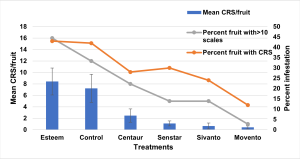
Treatments should be applied to provide thorough coverage according to the size of the trees, except for Movento which is recommended at 250 GPA. See UC IPM guidelines for CRS for more application details and recommendations.
References
Gautam SG, SK Dhungana. 2023. California red scale insecticide trial, 2022. https://doi.org/10.1093/amt/tsad067
Grafton-Cardwell, EE, JT Leonard, MP Daugherty, DH Headrick. 2021. Mating Disruption of the California Red Scale, Aonidiella aurantii (Hemiptera: Diaspididae) in Central California Citrus. 114: 2421-2429
Grafton-Cardwell, EE, SJ Scott, and JE Reger, 2016. California red scale insecticide efficacy trial, 2016. https://doi.org/10.1093/amt/tsx044
UCIPM guidelines 2022. Citrus Pest Management Guidelines: Selectivity of Insecticides and Miticides.
https://ipm.ucanr.edu/agriculture/citrus/selectivity-of-insecticides-and-miticides/
UCIPM guidelines 2022. Citrus Pest Management Guidelines: California red scale and yellow scale. https://ipm.ucanr.edu/agriculture/citrus/california-red-scale-and-yellow-scale/










